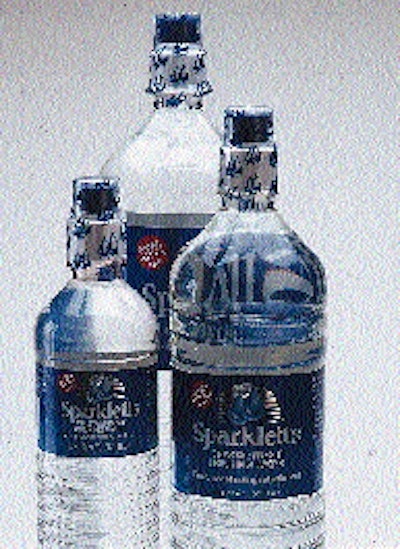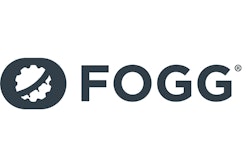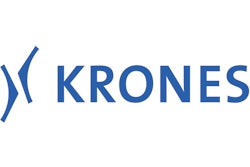At the Santa Ana, CA, plant of McKesson Water Products Co., the centerpiece of a plant-wide modernization effort is a brand new water bottling line running half-, 1- and 1.5-L bottles of polyethylene terephthalate. These bottle sizes were formerly filled for McKesson by contract packagers. By bringing the production in-house, McKesson gains significant cost savings and better inventory control. The new line handles half-L bottles at 300/min, 1-L at 240, and 1.5-L at 200/min. The front half of this impressive operation, from bulk depalletizing to labeling, is anchored by a filler and capper that share the same drive and mounting in a monoblock. The two machines are enclosed in a clear module overpressurized with filtered air that keeps contaminants away from the water and its container. In most water bottling plants, it's common to have a completely walled-off and overpressurized room for filling, but at McKesson there wasn't room for such an approach. This modular enclosure was the perfect solution. "It's handy in a small setting," says Dave Mateus of Mateus Sales (Brea, CA), who represents many of the machinery manufacturers who contributed to the line and who assisted in line layout and installation. Inside this enclosure is a 38-valve gravity filler from Fogg (Holland, MI) and a 12-station rotary capper from Alcoa (Indianapolis, IN). Just outside is the other key component in the capping picture: a cap feeder/orienter, from Aidlin Automation (Sarasota, FL), that delivers the push/pull "sports cap" to the capper. Creative Packaging (Buffalo Grove, IL) supplies the two-piece injection-molded polypropylene caps. "This was the first Alcoa machine capable of applying a sports cap," says Bruce Potter, project engineer at McKesson. "The real trick to that cap is getting it oriented, and Aidlin's device does that very efficiently." Aidlin calls its machine a "three-in-one solution" because in one self-contained unit it holds caps in a bulk hopper, elevates them, and orients them. It's capable of feeding caps at speeds as high as 2귔/min, which is why Aidlin's Roy Hoak calls it "the Ferrari of feeders." McKesson's speed requirements, of course, are more modest than that. More significant to McKesson is Aidlin's guarantee that 100% of caps handled will be properly oriented. "Caps fall off or stay on the elevator belt based on the cap's center of gravity," explains Hoak. The elevator belt Hoak refers to is about three feet across and is lined with horizontal "shelves" that protrude out from the belt about 1". The caps drop onto these shelves as the belt rotates past the bulk hopper. If a cap is resting open side out, so the spout and clear overcap are up against the belt, it will stay on the shelf all the way to the top of the machine where caps leave the shelves and drop off into the infeed chute. However, if a cap is sitting on a shelf open side in, so that the opening is touching the elevator belt, the cap's center of gravity will cause it to drop from its shelf before it reaches the point where caps drop into the infeed chute. Starts with depalletizing Upstream from the monoblock filler/capper is the bulk depalletizer that begins the line. Supplied by Priority One (Waterloo, Ontario, Canada), it uses vacuum pickup cups to remove and stack slip sheets. Then it sweeps layers of bottles, supplied by Constar (Atlanta, GA), onto a mass discharge conveyor. "The Priority One system had most of the features we liked, and they were willing to change a few things when we asked," says Potter. One thing he especially likes is the soft start feature the depalletizer has. "It lets the motors ramp up instead of just coming on at full speed. With a pallet of PET bottles stacked eight feet high, you need to ease it into motion." Handling of slip sheets is also very smooth, notes Potter. "In fact, that was one of its chief attractions, its smoothness in operation," says Potter. All empty bottle handling is controlled by a PLC in the depalletizer. The filler sends signals to this PLC, which then directs the variable-speed conveyors and the rinser ahead of the filler to adjust their speeds to meet the filler's needs. Also contributing to line control in this segment of the line are sensors that detect gaps between bottles. There's one between the rinser and the filler, for example. If it detects a gap between bottles, it signals the PLC to speed up the variable-speed rinser. "These incremental speed changes are being made all the time," says Potter. "The whole idea is to avoid starting and stopping." Bottles are single-filed in an area where guide rails close in to create an increasingly narrow space for bottles to pass through. Assisting in the proccess are individual conveyor belts in the tabletop conveyor that have incrementally varying speeds to draw the bottles out into a long thin stream just as the guide rails are narrowing around them. The challenge of PET Like others, McKesson has found empty PET bottles plenty challenging to handle. "With the two larger sizes we're doing well without having a full-time operator standing there to take care of downed bottles," he notes. With the half-L size, there's still room for improvement, he adds. Rinsing is done by a system from Bevco (Surrey, British Columbia, Canada). It uses side-grip belts to invert each bottle, spray it, drain it, and return it back to the conveyor. "There's only some 15 feet or so between rinser and filler, and there's no accumulation table between them, so variable-speed bottle control has to be especially accurate here," says Potter. Bottles enter the 38-valve gravity filler by way of a starwheel infeed that places each bottle on its own platform. As bottles leave the filler and move toward the capper by means of a starwheel transfer, the bottles ride up a ramp that raises them until the neck gripper of the capping machine comes around and grabs the neck just below the neck ring. The capping head picks a cap from the infeed chute, descends by cam action onto the bottle, and torques the cap on. A pair of small bottle control "knives," as Alcoa calls them, hold the neck from opposite sides just below the neck ring to keep the bottles from spinning in place as caps are torqued down. Since bottles are suspended by their neck rings during torquing, there is no pressure exerted on the bottles' sidewalls and no air is squeezed out of the headspace either. This is especially significant with a noncarbonated beverage, says Potter, because there is no internal gas pressure in the liquid to add stability to the bottle once it's released into distribution. The only internal gas pressure available is what's in the head space, and it isn't much. If capping caused headspace air to be evacuated, McKesson would likely encounter the "soft bottle syndrome," which makes bottle handling difficult all around and reduces vertical stacking strength. Leaving the capper, bottles are conveyed past a Videojet (Wood Dale, IL) ink-jet coder that date codes bottles on their shoulders. At this point bottle speed is still controlled by signals generated by the filler. But a short distance later, bottles phase onto a fixed-speed conveyor section and then onto a conveyor controlled by signals from the Canmatic hot glue labeler supplied by Krones (Franklin, WI). "The Krones equipment was selected on the same basis as the Videojet coder," says Potter. "They probably have more machines out there doing what they do than anyone in the business." Full-wrap paper labels applied by the high-speed rotary labeler are 60-lb stock printed offset in five colors plus coating. They're supplied by Reprints, Inc. (San Marcos, CA). Mounted beside the labeler is a Krones Garantomat neck-band applicator. From tubestock, it cuts and applies TE bands that are shrunk to a tight fit by a heat tunnel. Supplied by Templock Corp. (Carpinteria, CA), the polyvinyl chloride shrink bands are randomly printed with a unique water drop logo in custom blue ink that matches the McKesson label. Once bottles are discharged by the labeler/neckbander, all subsequent conveyors have a fixed rather than variable speed. The only real production "cushion" that remains is another accumulation table a short distance after the labeler. It can collect about 10 minutes worth of production should there be a delay or jam downstream. (See next month's issue for a look at McKesson's innovative approach to secondary packaging.) Running now since February, the line continues to improve as operators and engineers continue to fine-tune it. Costing some $3.2 million, it didn't come cheap. And payback won't come for three years. But after that, the cost of copacking will be but a distant memory.






























